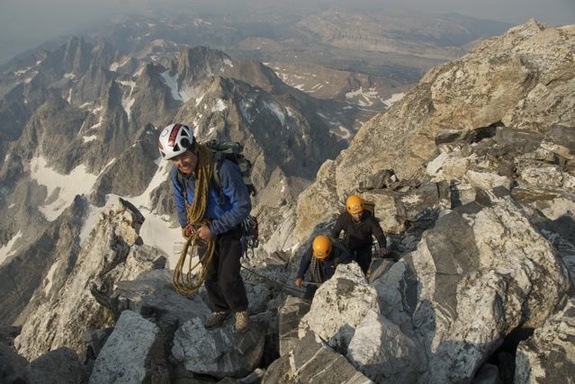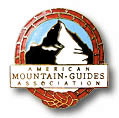| The Value of Hiring a Guide |
|
Hiring an American Mountain Guides Association (AMGA) Certified Guide or Accredited Program can help you learn the essential skills of mountaineering or turn your dream climb into a reality.
AMGA Certified Guides come from many different backgrounds and have a variety of talents and ambitions but one thing unites them all: the desire to rise to their full potential, excel at what they do, and become the best mountain guide they can be. AMGA training allows mountain guides to realize these desires. As the sole U.S. member of the IFMGA (International Federation of Mountain Guides Association), our certified guides have undergone rigorous training and examination that meets and exceeds international standards.
Building a relationship and getting involved with an AMGA Certified Guide or Accredited Program is a great way to gain mastery of climbing and skiing technical skills or reach the summit of your heart’s desire. AMGA guides bring a unique set of characteristics to the mountains. With a combination of great personality, a focus on maximizing client reward, excellent teaching ability, and emphasis on safety, our guides are sure to improve your mountain experiences.
The AMGA certifies individuals in the following disciplines. For a summary of the terrain guidelines covered by the certification and a complete list of the certified guides in each discipline please click on a link below.
* IFMGA (international certification)
* AMGA Certified Rock Instructors
* AMGA Certified Rock Guides
* AMGA Certified Alpine Guides
* AMGA Certified Ski Guides
* AMGA Certified Ski Mountaineering Guides
* AMGA Certified Single Pitch Instructors
* AMGA Certified Top Rope Site Managers
* CWA/AMGA Certified Climbing Wall Instructors
In addition, the AMGA also accredits guide services and climbing programs.
|
|
| Certification - Accreditation, what's the difference? |
|
| AMGA and IFMGA/UIAGM Certified Guides |
|
An individual guide, who has been through an AMGA certification exam, demonstrates a high level of specific skills which separates the professional guide from the recreational climber. An individual can obtain certification in any or all of three primary disciplines: rock, alpine, and ski. The certification process requires a substantial investment of time and money which contributes to the guide’s high operating expertise and standards. Guides who have completed the rigorous AMGA certification process have met accepted worldwide standards of guiding expertise in areas such as hazard awareness, client care, terrain assessment, minimum resource impact techniques, high-angle rescue, and professionalism.
Each AMGA Certified Guide must complete specific training courses, including, first aid courses; career development classes, which offer a period of counseling or practical work; and, finally completing the examination, which utilizes real-world experiences to test the guide’s ability. AMGA certified guides are required to operate using only the certification and terrain limitations applicable to their level of certification, with the safety of the clients as a prime concern at all times.
|
|
|
The AMGA Accreditation Program provides quality assurance and peer evaluation which focus on the international standards for guided climbing, mountaineering, and skiing. The program was developed by professional guides and climbing instructors who are leaders in the outdoor industry. Accreditation provides a consistent and meaningful standard by which to judge the reliability and professionalism of a climbing service. The accreditation process examines core elements of a guiding service, including, operating guidelines; access; permits; insurance; employment and business practices; and, guide training. Having an accredited program informs the general public and land managers that the program utilizes guides who are certified, and that all guides in the program have received formal training appropriate to the terrain over which they guide.
The accreditation program is closely scrutinized. A program can lose accreditation in various ways, including, new ownership, failure of guides to meet the terrain requirements, a high incidence of fatalities or injuries, the loss of insurance, or a violation of the AMGA code of ethics, including illegal guiding or false marketing. Furthermore, accredited programs are assessed through spot reviews, which ensure compliance with accreditation guidelines. All accredited programs provide advanced and specific use-training, medical training and terrain training (e.g., avalanche training). In addition, the programs have supervision guidelines which guarantee up-to-date training.
|
|
The American Mountain Guides Association
|
|
For over 25 years, the American Mountain Guides Association (AMGA) has been dedicated to supporting the guiding community through excellence in education, standards and certification to enhance the quality of services provided to the public, while serving as a resource for accessing and protecting the natural environment. As a group the AMGA presents a strong, unified voice for high standards of the professionalism of guiding and climbing instruction in the United States. The AMGA is an organization grounded in powerful tradition that continues to evolve with the ever changing arena of mountain guiding and climbing instruction. We offer a series of training courses and exams designed to certify guides and climbing instructors to the highly respected, internationally recognized, standards of the AMGA.
The AMGA is our nation’s sole representative to the 21-member International Federation of Mountain Guides Associations (IFMGA), the international governing body responsible for guiding standards and education around the world.
The heart of the American Mountain Guides Association is its membership. Spread across the country, AMGA members represent an incredible variety of educators, outdoor enthusiasts, and environmental stewards. Just about every aspect of mountain guiding and instruction is represented through the AMGA’s vast member base: from the glaciated high-altitude peaks of the Alaska Range to the big walls of Yosemite, from the diverse climbing areas in the Rockies to the world class ice and rock climbing of the East Coast you will most likely find AMGA trained and certified guides or climbing instructors. These professionals could work in any part of the industry from instructors who teach on climbing walls and single pitch cliffs to guides guiding long rock routes, alpine climbs, and ski mountaineering trips. As a collective group, the AMGA is closely connected to almost every issue that faces the industry and our treasured crags, peaks, powder covered slopes, and frozen waterfalls.
Guiding in the mountains has been a profession in the U.S. that spans back to the start of the nation. Only in 1979 did a group of 12 guides decide that it was time to formalize an organization to represent the greater guiding community. As a result, the American Professional Mountain Guides Association was born. Over the next few years the “P” was dropped and the AMGA developed and grew throughout the United States.
The organization sharpened its focus of supporting the guiding profession by providing representation for land use access, education, training, and examination based on international standards for guiding. In 1997, the AMGA achieved one of its most notable accomplishments with acceptance into the International Federation of Mountain Guides Associations, IFMGA/UIAGM. As a member of the IFMGA, the organization’s educational and certification programs meet the international standards recognized by more than 20 nations worldwide.
Today the AMGA continues to develop its programs to meet changing standards and support the growing community of guides and climbing instructors in the United States. In addition, the organization has become a resource for land managers and outdoor industry leaders by promoting land stewardship, world-class training, and sustainable practices to protect our natural resources.
The mission of the American Mountain Guides Association is to support the guiding community through education, standards, and certification to enhance the quality of services provided to the public, while serving as a resource for accessing and protecting the natural environment. |
|



